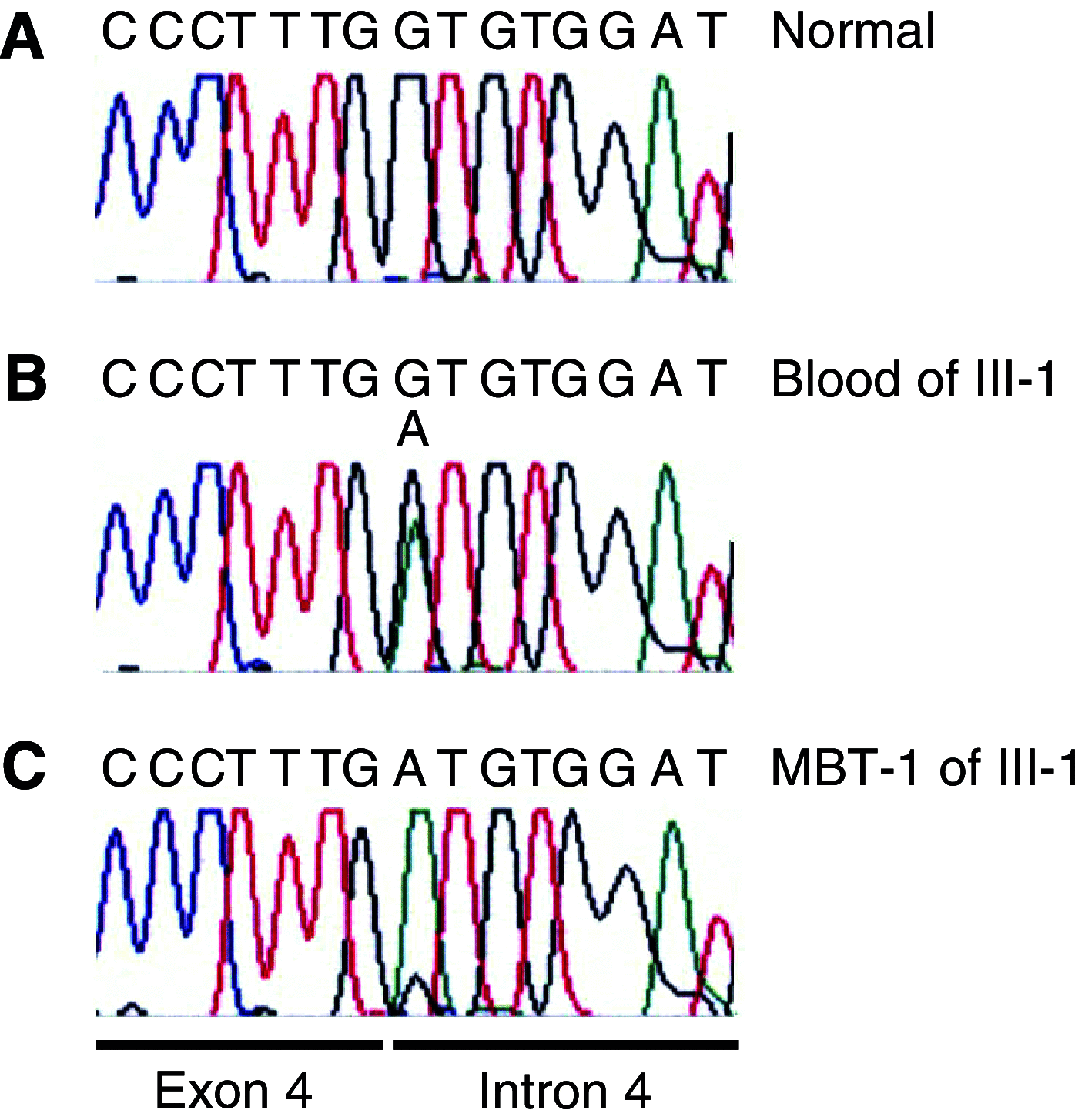Long-term survival and transmission of INI1-mutation via nonpenetrant males in a family with rhabdoid tumour predisposition syndrome
- PMID: 18087273
- PMCID: PMC2361463
- DOI: 10.1038/sj.bjc.6604156
Long-term survival and transmission of INI1-mutation via nonpenetrant males in a family with rhabdoid tumour predisposition syndrome
Abstract
Rhabdoid tumour predisposition syndrome (RTPS) is a rare syndrome caused by inheritance of a mutated INI1 gene for which only two multigeneration families have been reported. To further characterise the genotype and phenotype of RTPS, we present a third family in which at least three cousins developed an atypical teratoid/rhabdoid tumour (AT/RT) at a young age. Two of these patients showed unusual long survival, and one of these developed an intracranial meningioma and a myoepithelioma of the lip in adulthood. Mutation analysis of INI1 revealed a germline G>A mutation in the donor splice site of exon 4 (c.500+1G>A) in the patients and in their unaffected fathers. This mutation prevents normal splicing and concomitantly generates a stop codon, resulting in nonsense-mediated mRNA decay. Biallelic inactivation of INI1 in the tumours, except for the meningioma, was confirmed by absence of nuclear INI1-protein staining. The myoepithelioma of one of the patients carried an identical somatic rearrangement in the NF2 gene as the AT/RT, indicating that both tumours originated from a common precursor cell. In conclusion, this study demonstrates for the first time transmission of a germline INI1-mutation in a RTPS family via nonpenetrant males, long-term survival of two members of this family with an AT/RT, and involvement of INI1 in the pathogenesis of myoepithelioma.
Figures




Similar articles
-
Spectrum of SMARCB1/INI1 mutations in familial and sporadic rhabdoid tumors.Pediatr Blood Cancer. 2011 Jan;56(1):7-15. doi: 10.1002/pbc.22831. Pediatr Blood Cancer. 2011. PMID: 21108436 Free PMC article.
-
Predisposition to atypical teratoid/rhabdoid tumor due to an inherited INI1 mutation.Pediatr Blood Cancer. 2006 Sep;47(3):279-84. doi: 10.1002/pbc.20622. Pediatr Blood Cancer. 2006. PMID: 16261613
-
Molecular analysis of the rhabdoid predisposition syndrome in a child: a novel germline hSNF5/INI1 mutation and absence of c-myc amplification.J Neurooncol. 2003 Jul;63(3):257-62. doi: 10.1023/a:1024345221792. J Neurooncol. 2003. PMID: 12892231
-
The role of SMARCB1/INI1 in development of rhabdoid tumor.Cancer Biol Ther. 2009 Mar;8(5):412-6. doi: 10.4161/cbt.8.5.8019. Epub 2009 Mar 29. Cancer Biol Ther. 2009. PMID: 19305156 Free PMC article. Review.
-
A complex karyotype in an atypical teratoid/rhabdoid tumor: case report and review of the literature.J Neurooncol. 2011 Aug;104(1):375-80. doi: 10.1007/s11060-010-0478-0. Epub 2010 Dec 3. J Neurooncol. 2011. PMID: 21127945 Review.
Cited by
-
Atypical teratoid/rhabdoid tumor in the sella turcica of an elderly female with a distinct vascular pattern and genetic alterations.Virchows Arch. 2016 Dec;469(6):711-715. doi: 10.1007/s00428-016-2017-7. Epub 2016 Sep 5. Virchows Arch. 2016. PMID: 27595781 No abstract available.
-
Co-occurrence of schwannomatosis and rhabdoid tumor predisposition syndrome 1.Mol Genet Genomic Med. 2018 May 20;6(4):627-37. doi: 10.1002/mgg3.412. Online ahead of print. Mol Genet Genomic Med. 2018. PMID: 29779243 Free PMC article.
-
Current recommendations for clinical surveillance and genetic testing in rhabdoid tumor predisposition: a report from the SIOPE Host Genome Working Group.Fam Cancer. 2021 Oct;20(4):305-316. doi: 10.1007/s10689-021-00229-1. Epub 2021 Feb 3. Fam Cancer. 2021. PMID: 33532948 Free PMC article.
-
Where genotype is not predictive of phenotype: towards an understanding of the molecular basis of reduced penetrance in human inherited disease.Hum Genet. 2013 Oct;132(10):1077-130. doi: 10.1007/s00439-013-1331-2. Epub 2013 Jul 3. Hum Genet. 2013. PMID: 23820649 Free PMC article. Review.
-
Dominant-negative heterozygous mutations in AIRE confer diverse autoimmune phenotypes.iScience. 2023 May 5;26(6):106818. doi: 10.1016/j.isci.2023.106818. eCollection 2023 Jun 16. iScience. 2023. PMID: 37235056 Free PMC article.
References
-
- Biegel JA (2006) Molecular genetics of atypical teratoid/rhabdoid tumor. Neurosurg Focus 20: 1–7 - PubMed
-
- Bijlsma EK, Voesten AM, Bijleveld EH, Troost D, Westerveld A, Merel P, Thomas G, Hulsebos TJ (1995) Molecular analysis of genetic changes in ependymomas. Genes Chromosomes Cancer 13: 272–277 - PubMed
-
- Dimopoulos VG, Fountas KN, Robinson JS (2006) Familial intracranial ependymomas. Report of three cases in a family and review of the literature. Neurosurg Focus 20: 1–5 - PubMed
-
- Favre M, Butticaz C, Stevenson B, Jongeneel CV, Telenti A (2003) High frequency of alternative splicing of human genes participating in the HIV-1 life cycle: a model using TSG101, betaTrCP, PPIA, INI1, NAF1, and PML. J Acquir Immune Defic Syndr 34: 127–133 - PubMed
Publication types
MeSH terms
Substances
LinkOut - more resources
Full Text Sources
Medical
Molecular Biology Databases
Miscellaneous

